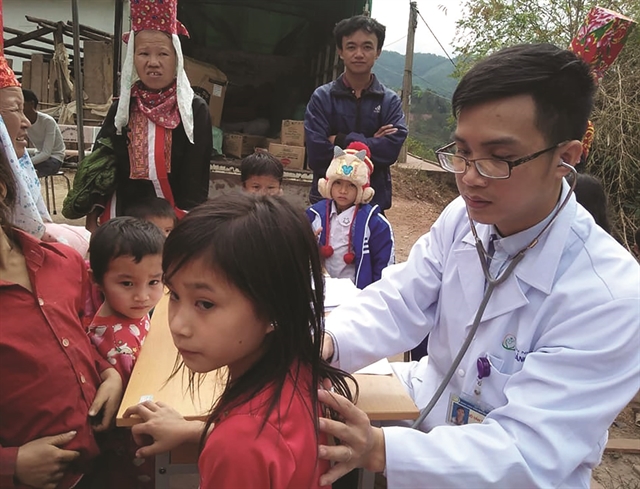 Society
Society

Việt Nam targets reducing the rate of underweight and malnousished children under five to less than 15 per cent by 2030.

|
Ethnic minority children in Bát Xát District, the northern mountainous province of Lào Cai. Child malnutrition remains a major problem in Việt Nam, especially among ethnic minority communities in remote areas. — VNS Photo Việt Thanh
HÀ NỘI – Việt Nam plans to reduce the rate of underweight and malnourished children under five to less than 15 per cent by 2030.
The target is set in a programme on the protection and development of ethnic minorities for 2021-2030 which has been approved by Prime Minister Nguyễn Xuân Phúc.
The plan prioritises ethnic minority people residing in 12 provinces, namely Cao Bằng, Hà Giang, Lào Cai, Yên Bái, Tuyên Quang, Lai Châu, Điện Biên, Sơn La, Nghệ An, Hà Tĩnh, Quảng Bình and Kon Tum.
It aims to drastically reduce maternal and child mortality rates as well as malnutrition among children under five, contributing to improving the quality of the population and ensuring equal development among ethnic groups.
Việt Nam is home to 52 minority groups who make up 14 per cent of its population of 96 million.
Child malnutrition remains a major problem in the country, especially among ethnic minority communities in remote areas.

|
| A doctor from Binh Liêu District Health Centre in the northern province of Quảng Ninh examines a child using a stethoscope. Photo baodantoc.vn |
According to the National Assembly’s Committee of Ethnic Affairs, the prevalence of undernutrition among ethnic minorities mainly exists in the Tây Nguyên (Central Highlands), North Central region and northern mountainous region. Ethnic minority groups that have the highest rates are Chứt, Bố Y, Rơ Măm and Si La with 40, 35, 30 and 21.7 per cent, respectively.
A World Bank report released in December last year found that nearly 1 in 3 ethnic minority children are affected by stunting, more than twice as much as the Kinh majority; and 21 per cent of ethnic minority children are underweight, a ratio 2.5 times higher than that of their Kinh peers.
Stunting is linked to lower economic productivity, including a 10-per cent reduction in lifetime earnings. When multiplied across an entire nation, poor nutrition can cost a nation up to three per cent of its GDP annually, it says.
According to the programme, by 2025, the rate of underweight and malnourished children under five will be reduced to less than 20 per cent.
The number of child marriages and consanguineous marriage will be cut by 2-3 per cent per year and more than 35 per cent of youths would receive pre-marital advice and health examinations for early detection of infectious diseases and HIV.
The rate of maternal mortality will decrease by 25 per cent and mortality rate among children under one will fall by 2-5 per cent.
At least 50 per cent of pregnant mothers and newborns will be screened for the four most common congenital diseases.
By 2030, the number of child marriages and consanguineous marriage is expected to be reduced by 3-5 per cent per year, while more than 50 per cent of youths will receive pre-marital advice and health examination for early detection of infectious diseases and HIV.
At least 70 per cent of pregnant mothers and newborns will be screened for the five most common congenital diseases.
Nearly all ethnic minority people aged between 15 and 60 can read and write. Up to 70 per cent of workers will receive appropriate training required for local development.
In November last year, the National Assembly passed a resolution on the master plan on socio-economic development in ethnic minority-inhabited, mountainous and extremely disadvantaged areas in the 2021-2030 period.
Under the master plan, by 2025, the income of the ethnic minority population would double that of 2020’s figure while the ratio of poor households would fall by 3 per cent a year.
Infrastructure-wise, all schools, classrooms and medical stations are expected to be built or upgraded with duration in mind, 100 per cent of communes are expected to have cement roads leading to their centres, 99 per cent of households have access to the national power grid or other suitable power sources, 90 per cent of the residents have access to clean water and 100 per cent of the population have access to television and radio.
By 2030, average income per capita of ethnic minority people would account for half of the national one. The poverty rate will be cut to under 10 per cent.
The plan also sets the targets of having 40 per cent of the ethnic minority population being capable or trained in industrial jobs, tourism and service sectors, while 80 per cent of rural households are to be engaged in commercial agricultural production. – VNS




